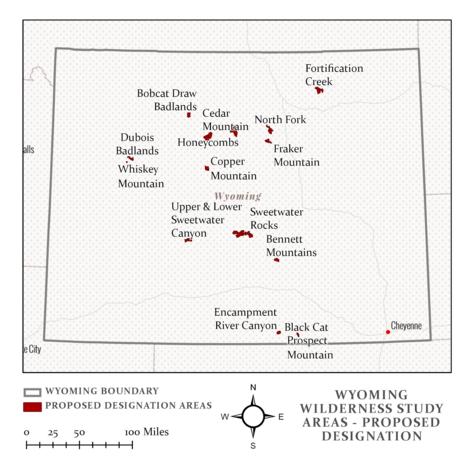WASHINGTON, DC – U.S. Senator John Barrasso (R-Wyo.), ranking member of the Senate Committee on Energy and Natural Resources, introduced legislation today that would resolve the management status of thousands of acres of federal public lands in seven counties in Wyoming.
The bill is the direct result of a collaborative process started under the Wyoming Public Lands Initiative (WPLI). The WPLI was created by the Wyoming County Commissioners Association in 2015 to seek locally driven solutions on the future of federal public lands that have been in management limbo for more than 30 years.
“For the first time in decades, we have a real opportunity to remove federal roadblocks that have stalled the future of wilderness lands in Wyoming. This bill is the result of years of hard work by county commissioners, outdoor enthusiasts, conservation leaders, and various other local officials involved in the Wyoming Public Lands Initiative (WPLI),” Barrasso said. “Wilderness Study Areas across Wyoming have been essentially locked up for more than three decades. Locally driven processes like the WPLI give people in Wyoming the best chance to decide how to treat these lands. This bill strikes a balance between protecting the places people in Wyoming love while expanding multiple-use areas that our state relies on.”
“The Wyoming Public Lands Initiative is a collaborative, county-led process to develop management direction for Wyoming’s wilderness study areas – public lands in legal limbo for decades,” WCCA Executive Director Jerimiah Rieman said. “WPLI committee members dedicated countless hours visiting WSAs, evaluating and debating proper use and management, and developing detailed and thoughtful proposals with the public. These committees and Wyoming citizens and visitors should take pride in this bill and its commitment to managing Wyoming’s public lands and resources for current and future generations.”
“Trout Unlimited is encouraged to see critical cold water fisheries like the Encampment River and Sweetwater River canyons protected,” Trout Unlimited North Platte River Water Project Manager Jeff Streeter said. “We look forward to working with the Senator and his staff on this legislation. I appreciate the Senator’s leadership and know that he values public lands as much as his fellow Wyomingites.”
“The Wyoming Public Lands Initiative is local influence at its finest,” Fremont Public Lands Chair Doug Thompson said. “Local citizen committee members sought and considered public input, shared their thoughts and desires in a respectful forum, and made every effort to reach consensus. We thank Senator Barrasso for advancing our recommendations.”
Background
Wilderness Study Areas (WSAs) are a special designation for lands that are managed to protect wilderness characteristics until Congress specifically designated them as Wilderness or directs the Bureau of Land Management (BLM) to manage the area for multiple uses.
WSAs were intended to be temporary designations. These particular temporary designations have persisted for more than 30 years.
In 2015, the Wyoming County Commissioners Association (WCCA) initiated the WPLI to provide a framework for counties to discuss and resolve various public lands issues around the state. The process was intended to focus on resolving the status of the 45 Wilderness Study Areas around Wyoming. It allowed all 23 counties to “opt in/out” of the process based on suitability for their county and to determine the composition and rules of their committees.
As a result of the WPLI process, the following seven counties in Wyoming have submitted their recommendations that are included in the legislation: Campbell, Carbon, Fremont, Hot Springs, Johnson, Natrona and Washakie counties.
The legislation includes:
– 5 wilderness designations totaling 20,381 acres
– 3 designations of a “Special Management Area” totaling 27,711 acres
– 10 release and manage as multiple-use totaling 99,750 acres
– 2 policy directives

Maps courtesy of Wyoming Geographic Information Science Center
Click HERE for a more detailed list of the designations included in each county and HERE for a map of the areas included.
